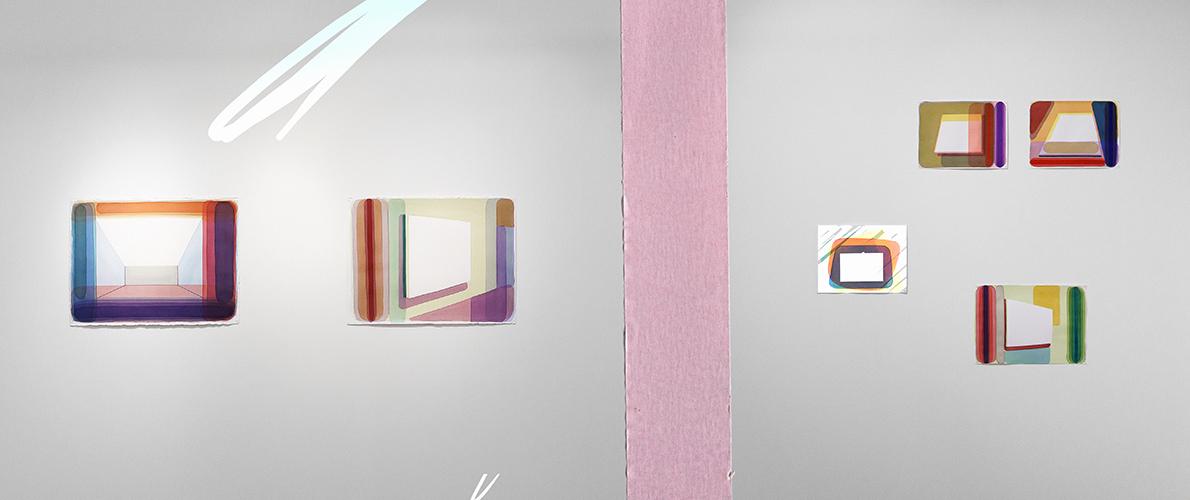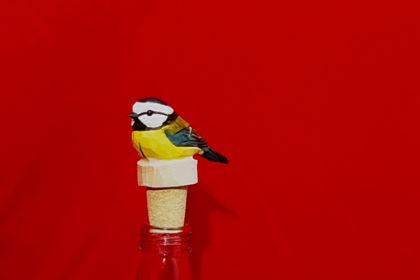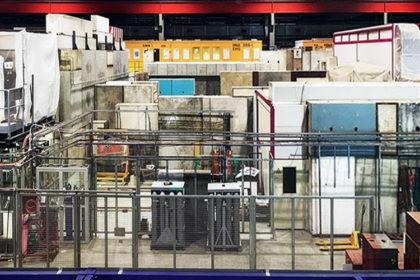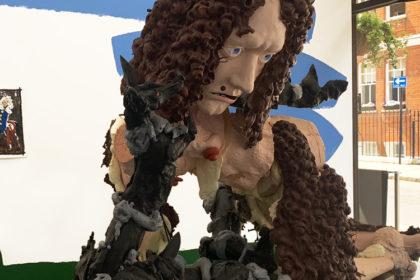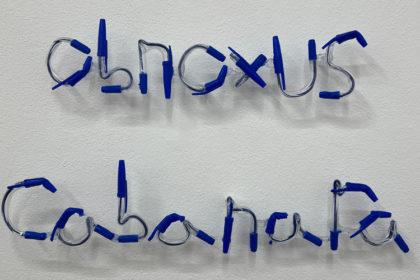Authour: Katya Babikova
Some theorists point to the total victory of the gaze in the perception of reality by the European subject. This means that projecting our inner images and expecting visual representations to confirm our understanding of all things is often a way how our gaze perceives reality. This certainly happens while we attend art exhibitions. Even the classic text of decolonial thought by Timothy Mitchell defines European exhibitionary order as “a place of spectacle and visual arrangement, of the organization of everything and everything organized to represent” [1]. Today, such criticism can be used about exhibitions worldwide. An exhibition as a medium is constructed and guided by the logic of representation regardless of its geography. Globalization processes have spread certain exposition standards everywhere. As an example, many totalitarian regimes around the globe often use exhibitionary order as an instrument to serve a certain ideology. There are various artists working with the exhibit as a medium. There exist artistic practices that study the relationships and interactions of viewers with objects of art, the existence of works of art in a certain environment, the viewer’s perception and its ideological construction. However, interesting and rare optics can be found by looking at the exhibition from within the work of art itself.
Russian artist Vladimir Logutov explores these processes, actively using the optics of the art object itself, which returns the gaze to the viewer. His canvas is often composed of images of paintings in an expositional space. Such works often perform as a sort of mini exhibition on the wall. He, as an author, is interested in designing artistic situations circum art objects. He creates assemblages of paintings and drawings on canvas and exhibition walls; sometimes using figurative silhouettes, abstract shapes, watercolor light and transparency, and digital prints. All parts of his work interact with one other.
Logutov is a laureate of the “INNOVATION Prize 2018” in the category “Artist of the Year”; his works are in the collection of the Tretyakov Gallery in Moscow, Moscow Museum of Modern Art, the FRAC Bretagne Museum in France and many others. He was born in Samara, where he studied at the Art College and Samara Pedagogical University; later relocated to Moscow and participated in several international artist’s residency programmes.
While Logutov considers painting and graphics to be his native medium, in general his projects are crossmedia. For example, when working with video, Logutov first of all creates films in which there is no narrative tied to any development over time. The mode of perception of his screen works is similar to the perception of painting. Video is simply a synthetic, convenient tool for speaking. Logutov is also actively involved in curating, and in his artistic practice pays great attention to exposition and space, designing artistic encounters and collisions.
One of the first projects that attracted significant institutional attention to the artist was the cycle of video works Twilight, in which Logutov flirts with the inattentiveness and inadvertence of the spectator. Most museum visitors encountering Logutov’s videos at the first superficial glance notice the ordinary landscape of a typical Russian city: crossroads, seemingly unremarkable everyday life. However, if they linger and fix their gaze strange metamorphoses emerge: cars drive on a red traffic light, but stop at the green one, the characters do not cast shadows, pedestrians disappear, someone walks behind the car and never comes out in the frame again. The artist is trying to awaken the attention of the audience by presenting an everyday plot injecting barely noticeable paranormal spatial shifts in it.

Vladimir Logutov. Twilight. 2005. Video. 5m. 28s.
As the medium of video is shown in a white cube, Logutov is aware that the audience rarely spends time watching video works from beginning to end. However, occupying the viewer’s time isn’t the artist’s goal. His videos can be watched from any moment, and for a limited amount of time. Twilight series can be articulated as the artist’s interest in working with the fixed gaze of spectators at an object considering its conditions of everyday life oversaturated with images. This project could also simply be articulated as creating a certain situation within the exhibition space.
Logutov’s videos demand concentration and focus in order to be deciphered.
Twilight is a zone of ambivalence, a zone of foggy visibility. The question of whether it is possible to see everything at once is analyzed by Paul Virilio and other prominent theorists. Virilio in The Vision Machine briefly describes how, with the proliferation of optical devices, “religious and cosmogonic uncertainties” begin to “proliferate” [2]. Following the history of painting first the background comes to the surface and illusion of depth is abandoned, then pictorial representation disintegrates, then the composition decomposes, figures and forms appear, but “soon only a visual message worthy of morse code will survive” [3].
We, as spectators, unconsciously classify the importance of what we see, and construct hierarchies and zones of primary and secondary visibility. At the same time, Virilio mentions the ambiguity of recognizing the fact that the essential can be invisible to the human eye. This leads on the one hand to ideological manipulations and, on the other, to the popularization of conspiracy theories. With Twilight series Logutov creates a situation where the viewer has a choice to participate. After all, the visitor can just walk by and not be curious.
Virilio makes a riveting observation that the evolution of optical apparatuses coincides with the “ubiquitous spread of taste for real or falsified ruins of monuments” [4]. If in Twilight Logutov works with the urban landscape snatching frames for his video and presents it the way his eye found it, then in his next ongoing series of works called Ruins of the Industrial, started in 2013, the artist materializes in sculptural form the state of ruin, decay and loss. Materials used are steel, rails, sheets of metal that create the illusion of crumpled texture, concrete and machine oil. Logutov talks about the underestimation of industrial ruins found in Russian cities, perhaps they could become a post-Soviet “Ancient Rome”, an archaeological heritage. The artist is interested in the situationist practices of studying the city and psychogeography – the influence of the environment on human condition.

Vladimir Logutov. From the “Ruins of the Industrial” series. 2013-2020. Steel. Concrete
Citizens in urban surroundings, who naturally happen to be spectators as well, are immediately influenced by their surroundings. The urban fabric of Russian cities has gone through a process of radical change within the last 30 years, and now seems to face new unpredictable transformations. The rapid transition from industrial large-scale production to the capitalist type of production marked the surrounding reality of the urban dweller during the 90s. The cities are marked by a historical shift of epochs: construction sites, deserted factories, unfinished shopping centers, abandoned buildings, unused obsolete materials. The urban spectator builds his route around these illusory immutable and yet decaying objects, and develops fascination by this ambivalence. Comprehending the collapse of industrial zones and their impact on urban space, the artist creates a park of ruins, of unutilized dilapidated things. Once in the exhibition hall, these objects imitate the memory of industrial space, enclosing the viewer in a memory of the past which shapes our perception of a particular environment in the present.

Vladimir Logutov. From the “Pieces of Metal” series. 2013. Blued steel
Despite the variety of used mediums, Logutov is primarily a painter and works with canvas, paints, graphics, and digital drawing. Accepting the total presence of screens that bombard us with images and their eventual role as intermediaries in our perception, he tries to reformulate the medium of painting in the context of contemporaneity. The artist wonders if canvas could be just another empty screen upon which signs are formed. The series of paintings Encounters is an attempt to curate an exhibition embedded in each artwork. Assembled in a certain way these paintings create a space where the viewer is invited to recognize colors and forms, observe the birth of image within a painting and trace perceptive automatisms and reactions.

Vladimir Logutov. From the “Meetings” series. 2014-2017. Watercolors.
In Next Level, from 2014-2017, the artist materializes through the exhibition situation the multi-level access to the object. Instead of receiving the desired object when coming to the museum space, visitors are confronted with the exhibited works as an intermediary between them and painting itself. Vladimir Logutov assembles picturesque compositions, like nascent quivering spaces, referring to the early avant-garde of Matiushin and Malevich. Then, these compositions find a place on the canvas next to one other. Then, silhouettes of spectators, exhibition walls and exposition space appear on the canvases. Paintings expand beyond the canvas and their life beyond the medium is imprinted in the architectural decisions of the space they might be presented in. As the artist himself says about his artworks “the viewers are confronted with the memory of the exhibition, the memory of the object, but never directly with the object itself”. It can be compared to browsing art on social media, it is this feeling that the artist reproduces in these projects. The viewer is once again surrounded by screens, and even painting begins to function in this logic.
Logutov constantly emphasizes that an artistic situation can be created not only via the exhibition. Refusing exhibitions-representations, Logutov creates new spaces for the perception of objects and studies the mutual influence of the gazes between spectator and the object, embeds painting in the phenomenology of perception changed by the influence of technology.
At the same time, technology does not necessarily devoid us of the ability to see, as Virillo suggested, rather it complicates our vision. This complexity can also be depicted with classical painting. The French philosopher Georges Didi-Huberman wrote in his work “What we see looks back at us”: “The act of seeing is not the action of a machine that perceives reality as a collection of tautological evidence. The act of showing is not the act of showing visible evidence to pairs of eyes that take possession of a one-sided “gift to see” in order to be satisfied with it one-sidedly. To show is to disturb the vision, in its act, in its subject. Seeing is an operation of the subject, which means that it is a splintering, disturbing, indignant, open operation. Each eye carries with it its opacity in addition to the information it may consider itself to possess at the moment” [5].
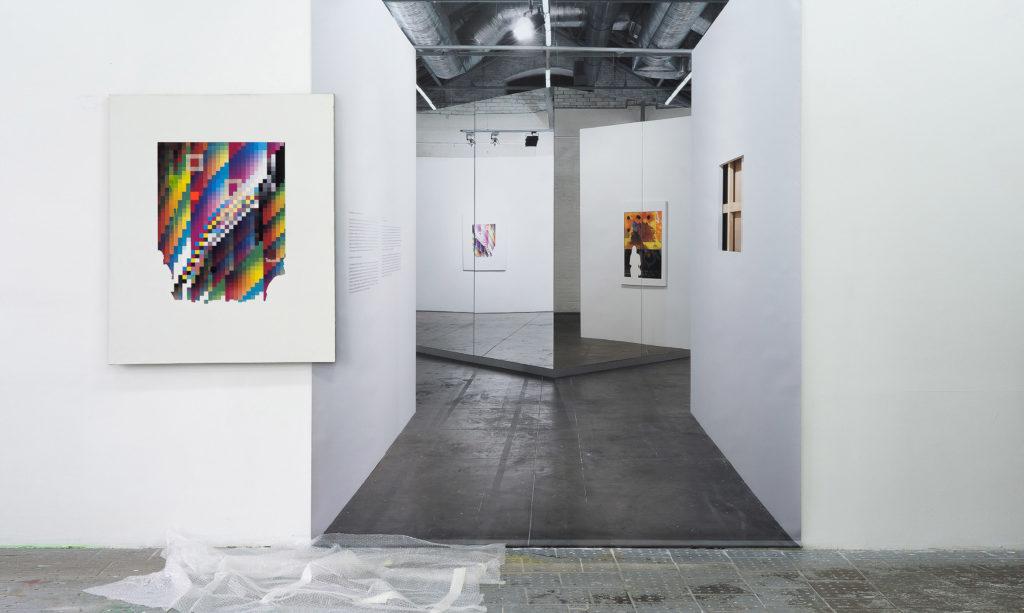
Vladimir Logutov. “Next Level” 2015-2019
Logutov does not give instructions for the perception of his works. The spectator is faced with the fact that he or she will see a (non)exhibition, or an exhibition, but inside a picture; or themselves in an exhibition, or memories of familiar environments; or an exhibition to which there is no direct access. Huberman continues: “…..binary thoughts, thoughts of a dilemma are incapable of comprehending the visual economy as such in any form. It is impossible to choose between what we see (….) and what looks at us (….). One can — and one must — be alarmed about the between(….)One must try to return to the point of inversion and reversibility, to the dialectical engine of all oppositions. This is the very moment when what we see is about to be overtaken by what is looking at us….” [6].

Vladimir Logutov. From the “Open Studio” project, 2021
The latest project of Vladimir Logutov is Open Studio, 2021, an exposition of dual paintings and series of talks with artist’s colleagues in his studio. As artist and curator Logutov creates an artistic situation, a space for (non)exhibition and invites others to discuss his method. Video recordings of these conversations continue the project. The works, carefully curated and presented on the walls of his studio, resemble an open book with both pages on canvas, a collision of two images in one painting. The artist uses all the mediums available to him to create images and intuitively confront and unite them simultaneously. The text accompanying the project is a manifesto on Logutov’s artistic method emphasizing the binary nature of the gaze, thought, and conditions for the existence of spectators and artists:
“Exhibition” and “show” should be distinguished.
There is a history of exhibitions and a history of art works.
The image and depiction.
The work as “adjective” and the work as “verb.”
Conjecture and fantasy.
Artistic behavior and artistic action.
The unimaginable and the impossible.
The pursuit of the image and drawing as a direct gaze.
The seeing of things and an obsession with the idea of the unprecedented.
The new is simple.
NOTES:
1. Timothy Mitchell, Orientalism and the Exhibitionary order/ Essay, 1992
2. Paul Virilio “The Vision Machine”/Indiana University Press, 1994
3. Ibid.
4. Ibid.
5. Georges Didi-Huberman “Ce que nous voyons, ce qui nous regarde”/ Minuit, 1992. The quote was translated from Russian to English.
6. Ibid.
Katya Babikova (born 1988, Russia) – curator and translator. Studied Directing at the School of Visual Arts in NY. Worked in contemporary art galleries in NY since 2012: Resobox Gallery (Japanese Cultural Center) and Soho20 Gallery. Currently lives in Barcelona, Spain.
Vladimir Logutov (born 1980) is a Russian artist. A participant in major international projects in the field of contemporary art. Author of about two dozen solo exhibitions in Russia and Europe. The artist’s works are both in private and museum collections, including collections of The State Tretyakov Gallery, Moscow Museum of Modern Art, FRAC Bretagne Museum and others. Vladimir Logutov is the winner of the Innovation Prize 2018, Artist of the Year; the winner of the Joseph Brodsky Prize 2018 in the visual arts.
Vladimir Logutov`s official website: https://logutov.art/

